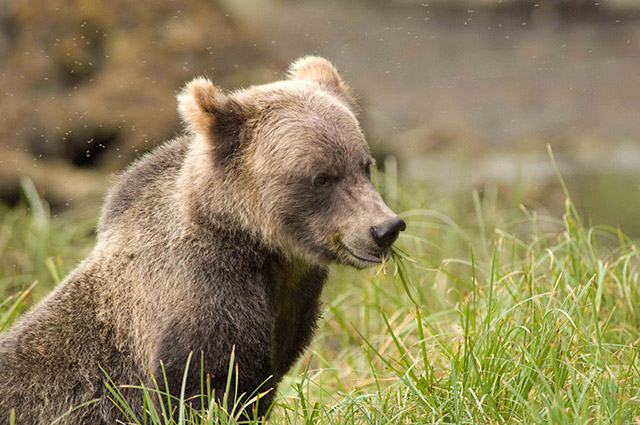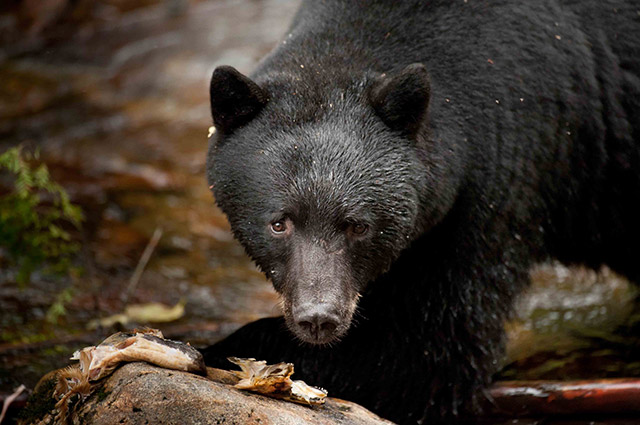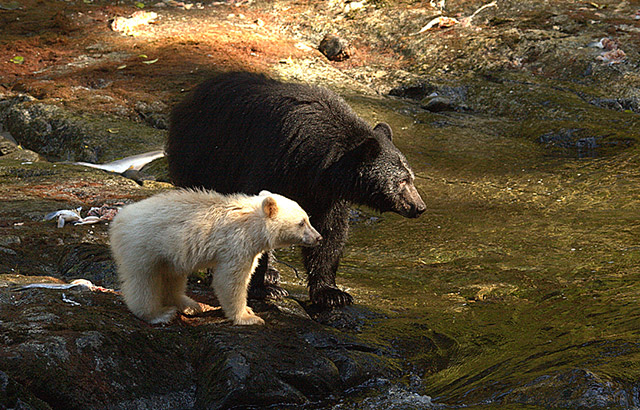|
| |
| 15. September 2013 |
Neue Website „Bears Forever“ der Coastal First Nations
zum Schutz der Bären im Great Bear Rainforest |
| |
| Seit 4. September ist sie da: Die neue Website „Bears Forever“ (www.bearsforever.ca), ein Projekt der Coastal First Nations in BC und der Central Coast First Nations Bear Working Group. Schon im September 2012 hatten die Coastal First Nations einseitig ein Verbot der Trophäenjagd auf Bären in ihren angestammten Territorien erklärt. Jetzt, zu Beginn der Herbstjagdsaison verleihen sie ihrer Forderung nochmals Nachdruck. Die Provinzregierung von BC unter Premierministerin Christy Clark weigert sich immer noch, die Trophäenjagd auf Bären zu verbieten und stellt sich als Interessenvertreter der Jagdveranstalter gegen die breite Mehrheit der Bevölkerung. Wissenschaftlich wie ethisch ist die Debatte um die Trophäenjagd längst ausdiskutiert. „The debate is over“, heißt es auf der Website „Bears Forever“: „Times have changed on the BC coast. With fewer fish and smaller trees, both animals and people are trying to adapt. For a large majority of British Columbians, killing bears for trophies no longer fits with modern values of stewardship and sustainability. Across the province, 87 % of citizens agree: it’s time to end the trophy hunt for bears in the Great Bear Rainforest. Even more (91 %) say hunters should respect First Nations laws and customs when on First Nations territory. Now nine First Nations on the coast have decided to take the lead.“ |
| |
 |
| Grizzlybär |
© Klaus Pommerenke |
|
| |
| Bei der letzten Meinungsumfrage vom Juli 2013 waren sogar 95 % der befragten Jäger selbst der Ansicht, dass nur Wild gejagt und getötet werden soll, das anschließend auch verzehrt wird („people should not be hunting if they’re not prepared to eat what they kill“). „Bears are not trophies“, sagte Jennifer Walkus von der Wuikinuxv First Nation. „They’re not a ‚natural resource‘ to be shot and skinned and left to rot. They’re our neighbours, and they deserve to stay a living, breathing part of the BC Coast, now and forever.“ Doug Neasloss aus Klemtu von der Kitasoo/Xai’xais First Nation erklärte: „Right now, as young leaders, it’s our job to rebuild local economies damaged by the collapse of fisheries and logging. We see ecotourism as a real opportunity. Wildlife viewing is a sustainable way to create local jobs, but not when trophy hunters are leaving bear carcasses in the same estuaries where we bring visitors.“ |
| „Right now, trophy hunters are descending of British Columbia’s Great Bear Rainforest for the fall bear hunt. Standing against them are the nine member nations of Coastal First Nations, ready to peacefully uphold the ban on trophy hunting. So are 87 % of British Columbians, who say, it’s time to protect our coastal bears, now and forever“, steht auf der Website zu lesen. Die Coastal First Nations sind eine Allianz der Wuikinuxv, Heiltsuk, Kitasoo/Xai’xais, Nuxalk, Gitga’at, Metlakatla, Old Masset und Skidegate First Nations und des Council der Haida Nation von Haida Gwaii. Die Central Coast First Nations Bear Working Group hat First Nations-Mitarbeiter in Rivers Inlet, Bella Bella, Klemtu und Bella Coola. Sie überwacht einen Bärenlebensraum von 45.000 km² Größe und koordiniert ihre nicht-invasiven Forschungsmethoden untereinander. So können Bären, die von einem Territorium in ein benachbartes Gebiet wandern, mittels DNA-Analysen gesammelter Haare wieder identifiziert werden. Es erfolgt eine enge Zusammenarbeit mit dem University of Victoria’s Applied Conservation Science Lab (Chris Darimont und Team) und der Raincoast Conservation Foundation. |
| |
 |
| Grizzlybär |
© Klaus Pommerenke |
|
| |
| Auf der Website „Bears Forever“ finden sich viele Informationen über die Bären der Great Bear Rainforest, über die „Guardians“ der Bear Working Group sowie Filmdokumente über Bären und natürlich auch der Film „Bear Witness“ über den fünfjährigen Grizzlybären namens Cheeky, der im Mai 2013 von einem Trophäenjäger erschossen wurde. Dieser Film ist bereits so bedeutsam, dass er seit 14. September auch im Telus World of Science in Vancouver gezeigt wird. Auf der Website können Sie auch Ihr persönliches Versprechen abgeben, das Verbot der Trophäenjagd auf Bären in den Territorien der Coastal First Nations anzuerkennen („sign the pledge“). Die „Faltering Light“-Petition zum Stopp der Trophäenjagd auf Bären, die im März 2010 gestartet wurde, haben zwischenzeitlich fast 63.000 Menschen unterzeichnet und auch Sie können es nach wie vor tun unter: www.gopetition.com/petitions/trophyhunt.html |
| Nachfolgend werden die Argumente der Coastal First Nations, die zum Verbot der Trophäenjagd auf Bären in ihren Territorien geführt haben und wie sie auf der Website „Bears Forever“ dargelegt sind, wiedergegeben: |
| „Trophy hunting for bears is banned in the Great Bear Rainforest. Here’s why: |
| Hunters should eat what they kill. |
| Over its lifetime a coastal bear will catch thousands of salmon and pick literally millions of berries. All that food is turned into hundreds of pounds of muscle and fat. Trophy hunters let it all go to waste. The hunters who shot and killed ‚Cheeky‘ the bear last May by the Kwatna river took only his head, paws and skin, leaving the rest of this healthy young bear’s carcass to rot in the estuary. This is fundamentally at odds with a First Nations value shared by people across BC: if you must shoot an animal, at least have the respect to make use of its meat. |
| Coastal trophy hunting is more than disrespectful; it’s unfair. Guides actually offer to barge in SUVs so hunters won’t have to hike. Bears can be spotted from planes, chased down in boats, or shot as they walk by camouflaged blinds. They’re hunted in the fall when they come down to feed on salmon, and then hunted in the spring when they emerge from hibernation. And unlike animals like deer or elk, there are no rules against shooting mothers. A third of the grizzlies killed in BC are female. |
| |
 |
| Schwarzbär |
© Klaus Pommerenke |
|
| |
| Trophy hunting makes no economic sense. |
| It’s true that American and other foreign hunters are willing to pay a lot of money to shoot a bear. Each black bear brings in roughly $ 10,000, part of which the guiding company pays out to the provincial government. The fee to kill a Grizzly bear can reach $ 25,000. But compared to ecotourism activities like bear viewing, revenues from bear hunting are negligible. In recent years, foreign hunters have shot an average of four grizzlies and 36 black bears every year in the Great Bear Rainforest. That adds up to less than half a million dollars, split between four or five guide outfitters – none of whom live on the coast where they bring hunters. |
| BC residents also hunt in the Great Bear Rainforest, and are responsible for another 55 or so bears a year. But the money resident hunters spend in local communities is minimal, and none of it represents new revenue from outside the province. Contrast that with wildlife viewing, which brings in visitors from around the world. The Spirit Bear Lodge, owned and operated by the Kitasoo/Xai’xais First Nation, employs 40 people in the remote village of Klemtu and is on track to gross more than $ 1 million dollars this year. The economic potential of bear viewing up and down the coast is huge, but not if trophy hunters are killing a hundred bears a year and scaring off the rest. |
| Bear hunting gets in the way of sound science. |
| The fact is, nobody knows how many bears there are in the Great Bear Rainforest. Government bureaucrats hand out hunting tags every year based on rough estimates, but until recently nobody was on the ground studying individual bears. That’s changing, thanks to a massive science project bringing together the University of Victoria, the Wuikinuxv, Nuxalk, Kitasoo/Xai’xais and Heiltsuk Nations, and Raincoast Conservation Foundation. Hair snags and video cameras now cover a 20,000-square-kilometer study area – the size of the country of El Salvador. Hairs picked up at sample sites are sent off for DNA analysis, revealing individual bears and their family members. |
| Those bits of fur – gathered without the bear even noticing – can also tell researchers what a bear has been eating and even her level of stress. When the same hair shows up at different sites, the bear’s movement can be tracked across hundreds of kilometres. |
| Combined with traditional knowledge and community-level monitoring of salmon returns, this project is building deep understanding of bears and their role in BC’s coastal ecosystem. One thing that’s clear is how quickly things are changing. Bears are abandoning areas where they’re supposed to be abundant, and turning up on islands where they’ve never been seen before. As salmon stocks dwindle, they’re resorting to other foods – and having fewer cubs. It makes no sense to allow bear hunting without an accurate picture of their populations. It’s worse when the bears killed are part of an active research project. |
| First Nations have a responsibility to protect bears. |
| Bears have been an integral part of human culture since time before memory. They factor into the songs, dances and crests of every First Nation on the coast. They are more than neighbours; in many families, they are considered relatives. That’s because bears move fluidly between the worlds in First Nations oral histories, transforming into people, even marrying humans. They are teachers, healers, and protectors. Killing a bear for no reason represents a grave breach of protocol – and never goes unpunished for long in the coastal legends. |
| Modern First Nations governments are responsible for the health of our territories, now and for future generations. When it comes to conservation issues in the Great Bear Rainforest, British Columbians look to Coastal First Nations for leadership. |
| For all these reasons, we have chosen to ban the trophy hunt for bears under tribal law. This fall, field personnel will notify hunters of the closure, and notify the bears if hunters approach. If necessary we will gather information on hunters, their boats and vehicles. However, our hope is that visitors to our territories will decide to leave behind their guns, and bring cameras instead. If so, local guides would be happy to introduce them to some truly magnificent bears.“ |
| |
 |
| Schwarzbärin (Kermode-Bär) mit weißem Spirit-Bär-Jungem |
© Douglas Neasloss |
|
| |
 zurück zurück |
|
|

